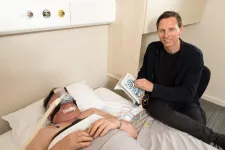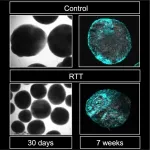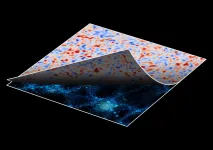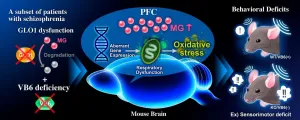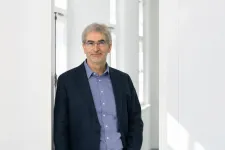(Press-News.org) In an Australian world-first, researchers have successfully repurposed two existing medications to reduce the severity of sleep apnoea in people by at least 30 per cent.
Affecting millions around the world, sleep apnoea is a condition where the upper airway from the back of the nose to the throat closes repetitively during sleep, restricting oxygen intake and causing people to wake as often as 100 times or more per hour.
Those with untreated sleep apnoea are more likely to develop cardiovascular disease, dementia and depression, and are two to four times more likely to crash a car than the general population.
Despite almost thirty years of research, there are no approved drug therapies to treat the condition.
Professor Danny Eckert, Principal Research Scientist at NeuRA and Professor and Director of Adelaide Institute for Sleep Health at Flinders University, has brought scientists one step closer by repurposing two existing medications to test their efficacy in people in sleep apnoea.
Previous research showed two classes of medication, reboxetine and butylbromide, were able to keep muscles active during sleep in people without sleep apnoea, and assist their ability to breathe.
By repurposing the medications, researchers used a multitude of recording instruments to measure whether reboxetine and butylbromide could successfully target the main causes of sleep apnoea.
This included balancing the electrical activity of muscles around the airway, preventing the throat from collapsing while people were sleeping, and improving the regulation of carbon dioxide and breathing during sleep.
Results from the study showed these medications did in fact increase the muscle activity around participants' airways, with the drugs reducing the severity of participants' sleep apnoea by up to one-third.
"Almost everyone we studied had some improvement in sleep apnoea," said Professor Eckert.
"People's oxygen intake improved, their number of breathing stoppages was a third or more less. We were thrilled because the current treatment options for people with sleep apnoea are limited and can be a painful journey for many," he said.
These new findings allow researchers to further refine these types of medications so that they have even greater benefit than what has currently been found.
"Next, we will look at the effects of these and similar medications over the longer term. We will assess whether we can harness the benefits of one drug without needing to use them both.
"Equally, we will test whether these treatments can be combined with other existing medications to see if we can improve their efficacy even more," said Professor Eckert.
Until now, the main therapy for sleep apnoea involves wearing a mask to bed, or Continuous Positive Airway Pressure Therapy (CPAP), which benefits millions.
However, many people find it uncomfortable and half the people that try it find it hard to tolerate. Plus, the efficacy of second line therapies, such as mouthguards fitted by dentists, can be unpredictable and expensive.
INFORMATION:
This study was funded by the National Health and Medical Research Council of Australia (NHMRC).
The article, The noradrenergic agent reboxetine plus antimuscarinic hyoscine butylbromide reduces sleep apnoea severity: A double-blind, placebo-controlled, randomised crossover trial (2021) by Richard Lim, Ludovico Messineo, Ronald R. Grunstein, Jayne C. Carberry, Danny J. Eckert has been published in the Journal of Physiology DOI: 10.1113/JP281912
About NeuRA
Neuroscience Research Australia (NeuRA) is an independent, not-for-profit research institute based in Sydney aiming to prevent, treat and cure brain and nervous system diseases, disorders and injuries through medical research. https://www.neura.edu.au/
About Flinders
The Adelaide Institute for Sleep Health at Flinders University conducts world-class research and teaching in respiratory and non-respiratory sleep disorders to improve health through the science of sleep. https://www.flinders.edu.au/adelaide-institute-sleep-health
Fukuoka, Japan--Medical researchers led by Kyushu University have revealed a possible underlying genetic pathway behind the neurological dysfunction of Rett syndrome. The team found that deficiencies in key genes involved in the pathology triggers neural stem cells to generate less neurons by producing more astrocytes--the brain's maintenance cells.
The researchers hope that the molecular pathology they identified, as reported in the journal Cell Reports, can lead to potential therapeutic targets for Rett syndrome in the future.
Rett syndrome is a progressive neurodevelopmental disorder characterized by impairments in cognition and coordination--with varying severity--and occurs in roughly one in every 10,000 to 15,000 female births. However, it ...
Japanese astronomers have developed a new artificial intelligence (AI) technique to remove noise in astronomical data due to random variations in galaxy shapes. After extensive training and testing on large mock data created by supercomputer simulations, they then applied this new tool to actual data from Japan's Subaru Telescope and found that the mass distribution derived from using this method is consistent with the currently accepted models of the Universe. This is a powerful new tool for analyzing big data from current and planned astronomy surveys.
Wide area survey data can be used to study the large-scale structure of the Universe through measurements of gravitational lensing patterns. In gravitational lensing, the ...
Microorganisms produce natural products, for example, as disease-causing virulence factors or as defense substances against predators and competitors. A team led by Dr. Robin Teufel and first author Ying Duan from the Institute of Biology II at the Faculty of Biology of the University of Freiburg, together with researchers from the University of Bonn, have now discovered a novel enzyme that is crucial for the production of so-called bacterial tropone natural products. The researchers presented their results in the current issue of the Journal of the American Chemical Society.
Previously unknown enzyme type
Bacteria found in terrestrial and marine environments produce tropone natural products, among other things, when they interact symbiotically with plants, algae or lower animals, for ...
Methylglyoxal (MG) is a highly reactive α-ketoaldehyde formed endogenously as a byproduct of the glycolytic pathway. MG accumulates under conditions of hyperglycemia, impaired glucose metabolism, or oxidative stress. An excess of MG formation causes mitochondrial impairment and reactive oxygen species (ROS) production that further increases oxidative stress. It also leads to the formation of advanced glycation end products (AGEs) due to MG reacting with proteins, DNA, and other biomolecules, which can induce aberrant inflammation via binding to receptors for AGEs (RAGE). To remove the toxic MG, ...
This insight is the result of the close collaboration of several research groups at the Max Planck Institute for Marine Microbiology. A team around Cedric Hahn and Gunter Wegener recently discovered ethane-degrading microbes at hydrothermal vents of the Guaymas Basin at a water depth of 2,000 meters in the Gulf of California. They named it Ethanoperedens thermophilum, which means "heat-loving ethane-eater". Cedric Hahn a PhD student from the research group Molecular Ecology cultured the ethane-degrading microbes in the laboratory. Hahn, Wegener and colleagues of the research group Microbial Metabolism, Tristan Wagner and Olivier Lemaire took a closer look at these microorganisms. This collaborative work unraveled the secrets behind ...
"We have studied which temperatures are preferable and which are harmful in humans, cattle, pigs, poultry, and agricultural crops and found that they are surprisingly similar," says Senthold Asseng, Professor of Digital Agriculture at TUM. According to the study, preferable temperatures range from 17 to 24 degrees Celsius.
When does it become too hot for humans?
At high humidity, mild heat strain for humans begins at about 23 degrees Celsius and at low humidity at 27 degrees Celsius. "If people are exposed to temperatures above 32 degrees Celsius at extremely high humidity or above 45 degrees Celsius at extremely low humidity for a lengthy period of time, it can be fatal," says Prof. Asseng. "During extreme heat events with temperatures far above 40 degrees Celsius, such as those ...
Plastics are a growing problem for natural ecosystems around the globe, and in particular for our marine and freshwater environments. Rivers are the leading source of plastic pollution, as it has been estimated that they deliver several million metric tons of plastic annually to our oceans from poor land-based waste management. The problem is that the estimates made for plastics flowing from the rivers are tens to hundreds of times higher than the quantity of plastics floating on the ocean's surface. So where is all of this river-derived plastic actually going - is there a missing plastic 'sink' somewhere in the ocean? Are the estimates correct?
In a paper published ...
Originally discovered as a bacterial mode of defense against invading viruses, the remarkable ability of CRISPR-Cas9 to modify specific locations of DNA has made it a researcher favorite among gene editing tools. The ongoing effort to explore further possibilities of the CRISPR-Cas9 system is ushering in newer developments to this tool. In one of the latest refinements of the technique, as illustrated in a study published in BioDesign Research, scientists from Stanford University, USA have developed a CRISPR-Cas9 system that induces highly effective silencing of target genes.
The versatility of CRISPR-Cas9 based gene editing is largely ...
New research published in The Journal of Physiology shows that researchers have successfully repurposed two existing medications to reduce the severity of sleep apnoea in people by at least 30 per cent.
Affecting around 1.5 million adults in the UK, sleep apnoea is a condition where the upper airway from the back of the nose to the throat closes repetitively during sleep, restricting oxygen intake and causing people to wake as often as 100 times or more per hour (1).
Those with untreated sleep apnoea are more likely to develop cardiovascular disease, dementia and depression, ...
NDIANAPOLIS--Indiana University School of Medicine researchers are developing a new, noninvasive brain stimulation technique to treat neurological disorders, including pain, traumatic brain injury (TBI), epilepsy, Parkinson's disease, Alzheimer's disease and more.
"Given the increasing use of brain stimulation in human brain study and treatment of neurological diseases, this research can make a big impact on physicians and their patients," said Xiaoming Jin, PhD, associate professor of anatomy, cell biology and physiology.
When someone experiences a brain injury, nerve injury, or neurodegeneration, such as in epilepsy and TBI, there is damage to the brain which can lead to loss ...
